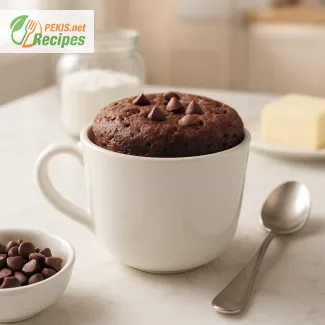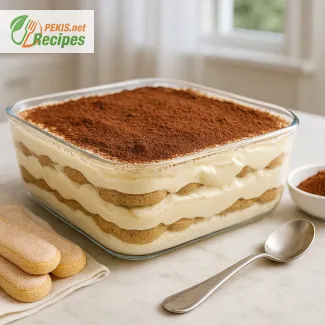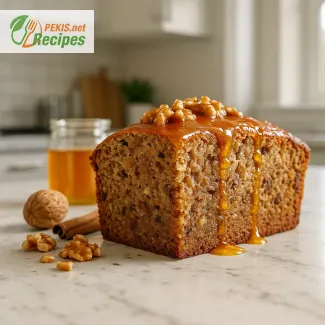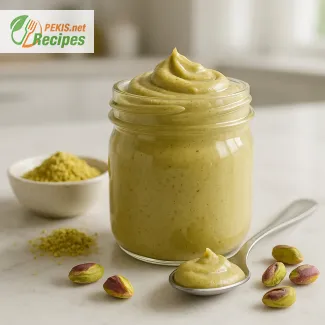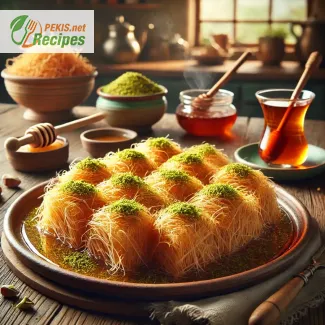
Discover the Delicate Flavors of Kadaif – A Crispy and Irresistible Dessert
A Time-Honored Turkish Delight
Kadaif, also known as Kadayif, is a beloved dessert deeply rooted in Turkish and Middle Eastern cuisine. This golden, crispy pastry, filled with crushed nuts and soaked in sweet syrup, has captivated generations with its delightful texture and rich flavors. The moment you take a bite, the contrast between the delicate crunch of the kadaif strands and the soft, syrupy interior creates an unforgettable experience.
Served on special occasions, festive gatherings, and religious celebrations, Kadaif is more than just a dessert—it is a symbol of hospitality and tradition. Whether enjoyed during Ramadan, Eid, or family celebrations, this dish embodies the essence of Turkish culinary heritage.
What Makes Kadaif So Special?
At first glance, Kadaif may resemble shredded phyllo dough, but its distinct texture sets it apart. The vermicelli-like strands are carefully layered, filled with a mixture of crushed walnuts, pistachios, or hazelnuts, and baked until golden brown. The final touch—a fragrant sugar syrup infused with lemon and spices—adds the perfect level of sweetness while keeping the pastry moist yet crisp.
Beyond its simple ingredients, Kadaif's charm lies in its contrast of textures. The crispy strands absorb the syrup while maintaining their lightness, making every bite an indulgence of crunchy, nutty, and syrupy perfection.
The History and Cultural Significance of Kadaif
The origins of Kadaif trace back centuries, with roots in the Ottoman Empire and influences from Greek, Arabic, and Balkan cuisines. Over time, this dessert has evolved, with each region adding its own unique twist. In Turkey, Kadaif is typically filled with pistachios or walnuts, while in Greece, it is often paired with creamy custard. In the Balkans, variations include layers of kadaif dough combined with cheese or cream.
Kadaif’s presence extends beyond home kitchens—it is a staple in traditional pastry shops, where artisans carefully craft it using techniques passed down through generations. Whether served warm with a scoop of creamy Turkish ice cream or accompanied by a strong cup of Turkish coffee, Kadaif is a dessert that invites you to slow down and savor each bite.
Key Ingredients That Bring Out the Best Flavors
While the ingredients for Kadaif are simple, their quality plays a crucial role in achieving the perfect dessert. Here’s what makes each element special:
- Kadaif Dough (Shredded Phyllo): The fine, delicate strands create the signature crispy texture. Fresh kadaif dough is preferred for its flexibility, while frozen or dried versions require slight rehydration.
- Nuts (Walnuts, Pistachios, or Hazelnuts): The nutty filling adds depth and richness, with each variety offering a unique flavor profile. Pistachios provide a delicate sweetness, while walnuts bring an earthy taste.
- Butter or Ghee: The key to achieving a golden, flaky crust is generous brushing with melted butter or ghee, which enhances the dough’s crispiness.
- Sugar Syrup: Made from sugar, water, and lemon juice, the syrup is poured over the baked kadaif, ensuring it remains moist and flavorful without becoming overly soggy.
- Aromatic Enhancements: Spices like cinnamon, cloves, and cardamom, along with a touch of rose or orange blossom water, elevate the syrup, adding an exotic and fragrant note.
Tips for Achieving the Perfect Kadaif
Creating the perfect Kadaif requires patience and attention to detail. Follow these expert tips to ensure your dessert is golden, crispy, and delicious:
- Use Fresh Kadaif Dough – If possible, opt for freshly made kadaif strands for better flexibility and a more authentic texture. If using frozen dough, allow it to thaw completely before handling.
- Toast the Nuts Lightly – For a richer flavor, lightly toast the nuts before incorporating them into the filling. This enhances their natural oils and brings out a more pronounced nutty taste.
- Don’t Over-Saturate with Syrup – Pour the syrup over the hot kadaif immediately after baking to ensure even absorption. Avoid using too much syrup, as it can make the dessert overly soggy.
- Bake Until Golden Brown – Achieving the perfect crispiness requires slow baking at a moderate temperature, ensuring the strands turn a deep golden hue.
- Let It Rest – Allow the Kadaif to rest for at least a few hours after adding the syrup. This helps the flavors meld together while keeping the pastry light yet indulgent.
How to Serve Kadaif for Maximum Enjoyment
Kadaif is best enjoyed warm or at room temperature, often garnished with a sprinkle of crushed pistachios or a dusting of powdered sugar. For an extra touch of indulgence, serve it with:
- A scoop of Turkish or vanilla ice cream – The cold, creamy texture complements the warm, syrup-soaked pastry.
- Whipped cream or clotted cream – Adds a luscious contrast to the crisp kadaif.
- A drizzle of honey – Enhances the natural sweetness without overpowering the delicate flavors.
- Traditional Turkish tea or coffee – The slightly bitter notes of strong Turkish coffee balance the richness of the dessert.
A Timeless Dessert Worth Savoring
Kadaif is more than just a sweet treat—it is a celebration of tradition, texture, and flavor. Whether you are preparing it for a festive gathering or simply indulging in a homemade dessert, this classic dish promises to transport you to the heart of Turkish culinary heritage.
Once you master the art of making Kadaif, it will surely become a treasured addition to your repertoire of desserts. With its crispy, nutty, and syrupy perfection, this dessert captures the essence of a truly delightful and satisfying experience.
- Prepare the syrup: In a saucepan, combine sugar, water, and lemon juice. Bring to a boil, then lower the heat and simmer for 10 minutes until slightly thickened. Remove from heat, add honey and orange blossom water, and let cool completely.
- Preheat the oven: Set your oven to 180°C (350°F).
- Prepare the kadaif dough: Gently separate the kadaif strands with your fingers to loosen them. Melt the butter and drizzle it evenly over the dough, tossing to ensure all strands are well-coated.
- Assemble the kadaif: Divide half of the buttered kadaif dough and spread it evenly in a greased baking dish. Press down lightly.
- Add the filling: Evenly distribute the chopped nuts mixed with cinnamon over the first layer of dough.
- Top with remaining dough: Spread the remaining kadaif dough over the nuts and press down gently but firmly.
- Bake: Place the dish in the preheated oven and bake for 35-40 minutes until golden brown and crispy.
- Add syrup: Once baked, remove from the oven and immediately pour the cooled syrup evenly over the hot kadaif. Allow it to soak for at least 1 hour before serving.
- Serve: Garnish with extra chopped nuts and serve warm or at room temperature.
Enhancing Kadaif: Elevate the Classic Recipe with Expert Tips
Exploring Variations to Perfect the Flavor
Kadaif is already an exceptional dessert with its crispy, golden strands and nutty, syrup-soaked filling, but there are several ways to enhance its flavor and texture. By modifying key ingredients and incorporating different preparation techniques, you can transform the traditional recipe into an even more indulgent or healthier version while still preserving its authentic essence.
One way to refine the taste is by experimenting with the nut filling. While walnuts and pistachios are the most common choices, almonds or hazelnuts can introduce a richer, slightly different depth of flavor. Almonds contribute a subtler sweetness, while hazelnuts provide a toasty, earthy undertone that pairs beautifully with honey-based syrups.
Another approach is adjusting the syrup composition. Traditional syrup is made with sugar, water, and lemon juice, but adding a hint of orange zest, cinnamon, or rose water can create a more aromatic and layered taste. Substituting white sugar with honey or maple syrup results in a slightly less intense sweetness while adding complexity to the flavor profile.
The Advantages of Homemade Kadaif Over Store-Bought Versions
Preparing Kadaif at home ensures that you have complete control over the quality of ingredients, leading to a dessert that is fresher and free of unwanted preservatives. Commercially prepared Kadaif often contains pre-packaged kadaif dough, which may be dried out or lack elasticity, affecting the final texture of the dessert.
By making it at home, you can ensure that the butter or ghee used is pure, rather than using margarine or oils commonly found in mass-produced versions. Freshly chopped nuts also have a much more pronounced flavor than pre-ground or packaged alternatives, making a noticeable difference in the overall taste.
Additionally, homemade syrup can be tailored to your preference by adjusting the sugar content and enhancing it with natural flavor infusions. Many store-bought kadaif desserts tend to be overly sweet, but when prepared at home, you can achieve the perfect balance between crispiness and moisture without making the dish too heavy.
Common Mistakes to Avoid When Making Kadaif
Achieving the perfect Kadaif requires careful attention to technique, and even small mistakes can impact the texture and taste. Here are some common pitfalls and how to avoid them:
Using Dry or Improperly Handled Kadaif Dough
Fresh kadaif dough is delicate and should be separated gently before use. If it is compressed or too dry, it may not bake evenly, leading to a tough and chewy texture rather than a light and crisp bite. Always loosen the strands carefully and coat them thoroughly with melted butter to prevent dryness.
Over-Saturating the Kadaif with Syrup
One of the biggest mistakes is pouring too much syrup over the kadaif, which can make it soggy rather than crispy. To achieve the ideal texture, pour the cooled syrup over the hot baked kadaif—this allows for even absorption without making the dessert too wet.
Not Baking It Evenly
To get an evenly golden, crisp exterior, the kadaif must be baked at the right temperature. If the oven is too hot, the outer layer will brown quickly while the inside remains undercooked. A moderate temperature of 180°C (350°F) for around 35-40 minutes ensures that the dough crisps up without burning.
Neglecting Resting Time
Kadaif needs at least one hour to rest after the syrup has been added. This allows the syrup to fully absorb into the layers, ensuring a balanced flavor in every bite. Rushing this step might result in uneven sweetness, where some parts are overly syrupy while others remain dry.
Healthier Alternatives Without Compromising Taste
For those who love Kadaif but want a healthier version, several substitutions can reduce sugar, fat, and calories while still maintaining the dessert’s deliciousness.
Reducing Sugar Content
Traditional Kadaif is quite sweet due to its syrup-heavy composition. A healthier approach is to reduce the sugar in the syrup by half or replace it with natural sweeteners like honey, agave syrup, or coconut sugar. These alternatives provide a more balanced sweetness and avoid the sharp sugar spikes caused by refined white sugar.
Using Whole Grain or Gluten-Free Options
Standard Kadaif dough contains refined wheat, but you can opt for a whole wheat kadaif dough for added fiber and nutrients. If you require a gluten-free alternative, some specialty stores offer rice flour-based kadaif strands, or you can use shredded phyllo pastry made from gluten-free flours.
Choosing Healthier Fats
Instead of using butter, which contains saturated fats, consider using olive oil, avocado oil, or coconut oil. These provide a lighter texture and contribute to heart health without compromising the crispiness of the kadaif strands.
Boosting Nutritional Value with Superfoods
To enhance the nutritional profile, consider adding chia seeds, flaxseeds, or finely ground almonds to the nut mixture. These superfoods provide essential omega-3 fatty acids, fiber, and protein, making the dessert more filling and nutrient-rich.
Creative Twists to Elevate Kadaif
If you want to give Kadaif a modern twist, try some unique variations that introduce new textures and flavors.
Adding a Creamy Layer
One popular variation includes a layer of creamy custard (Muhallebi) or ricotta cheese between the kadaif layers. This creates a delightful contrast between the crispy pastry and smooth filling, adding richness to every bite.
Infusing Spices and Flavors
Spices can add a unique depth of flavor. Try incorporating cardamom, nutmeg, or saffron into the nut mixture or syrup. These spices bring a warm, aromatic quality that enhances the traditional sweetness of the dessert.
Combining with Chocolate or Caramel
For an indulgent twist, drizzle melted dark chocolate over the baked kadaif before serving. The bitterness of dark chocolate balances the sweetness of the syrup, creating a sophisticated contrast. Alternatively, a salted caramel drizzle can bring a contemporary flavor profile while maintaining the essence of the classic dessert.
Why Kadaif Remains an Unforgettable Dessert
Kadaif is a dessert that transcends generations, offering a perfect blend of textures and flavors. Whether you stick to the classic recipe or explore healthier alternatives and creative twists, this dish continues to be a favorite in many households.
By carefully selecting high-quality ingredients, avoiding common mistakes, and considering modern variations, you can take Kadaif to the next level, ensuring that every bite is as crispy, flavorful, and memorable as it should be.
- Contains gluten (kadaif dough) and nuts (walnuts or pistachios).
- May contain traces of dairy (butter).
Ingredient Substitutions for Allergy-Free Version:
- Use gluten-free kadaif dough or replace with thinly shredded gluten-free rice noodles.
- Replace butter with dairy-free margarine or coconut oil.
- If allergic to nuts, substitute with toasted sunflower seeds or shredded coconut.
- Vitamin E: 1.2 mg (boosts skin and immune health).
- Magnesium: 25 mg (supports muscle function and nerve health).
- Iron: 1.5 mg (essential for oxygen transport in the blood).
- Calcium: 20 mg (contributes to bone strength).
- Polyphenols from nuts – help reduce inflammation and support heart health.
- Cinnamon compounds – aid in blood sugar regulation.
- Honey antioxidants – contribute to immune support and overall wellness.
